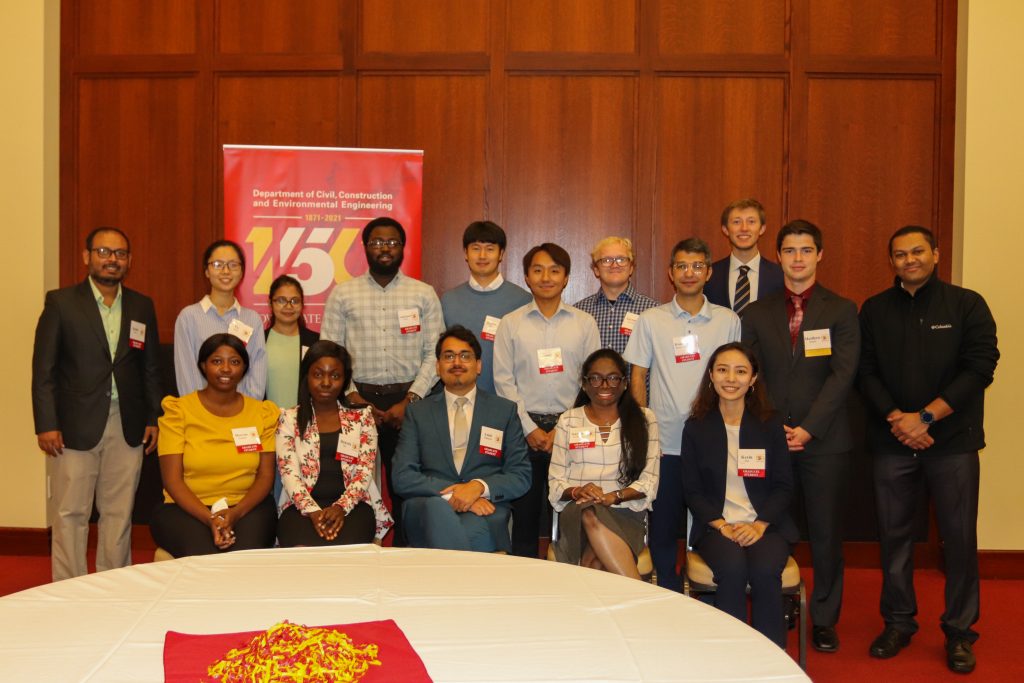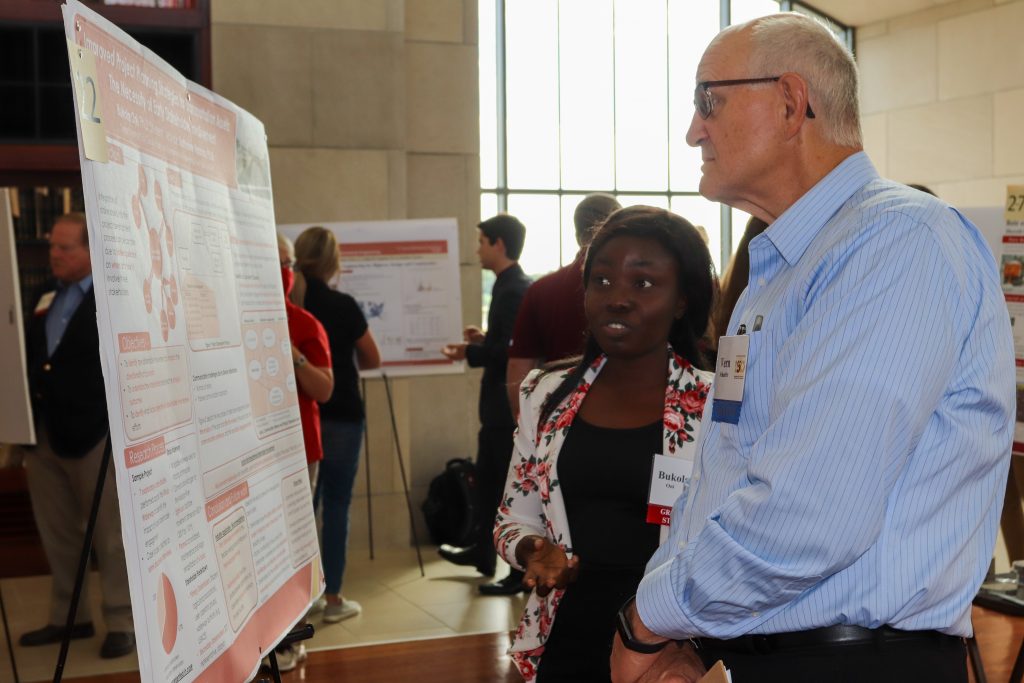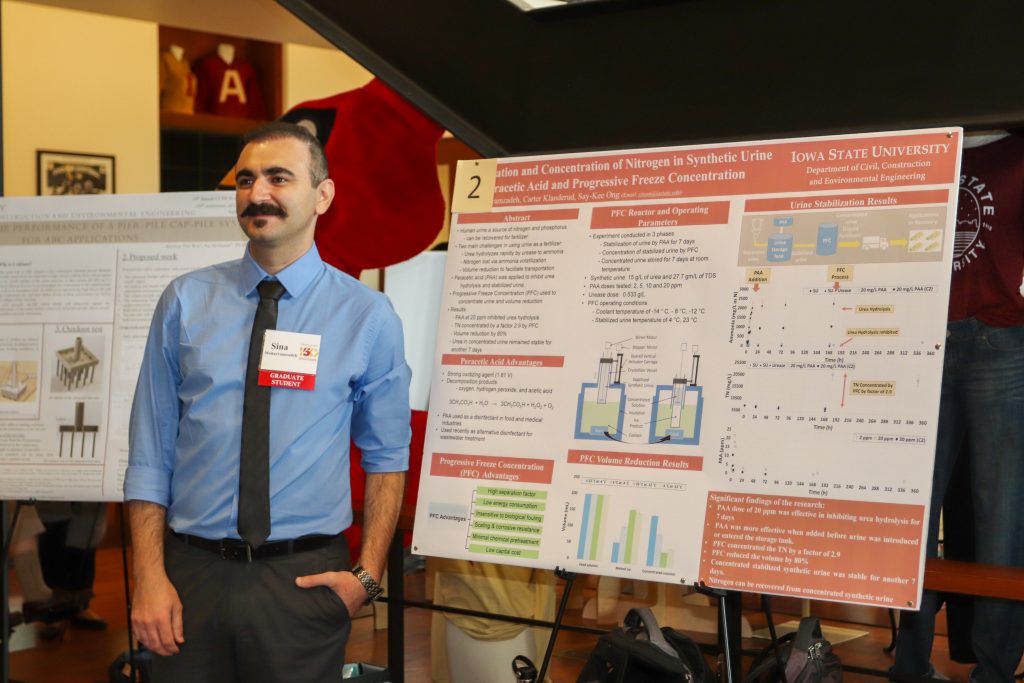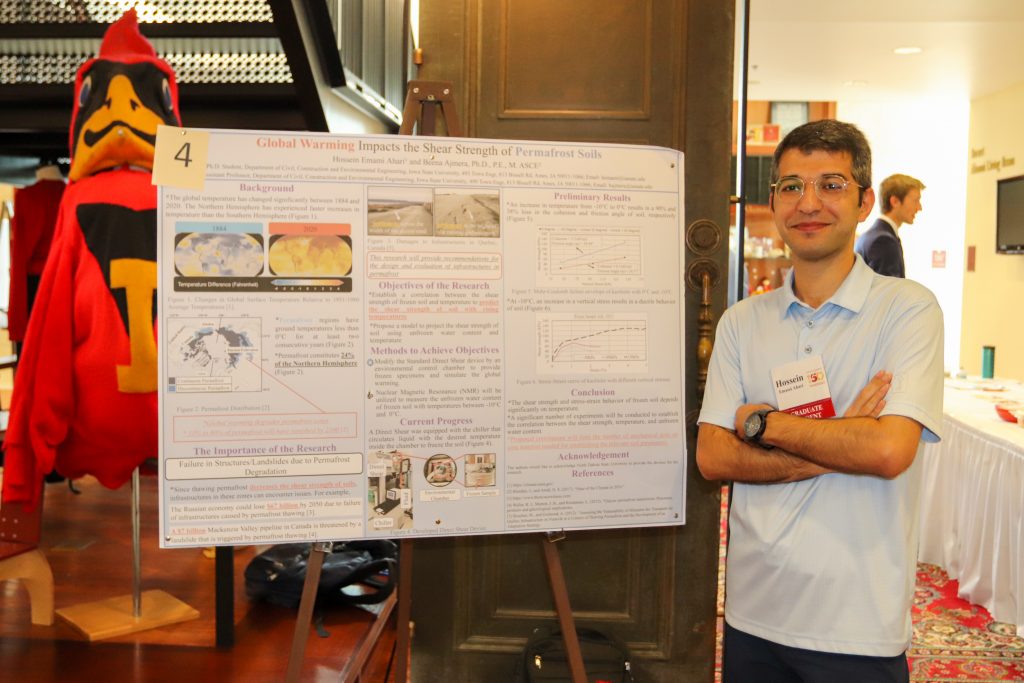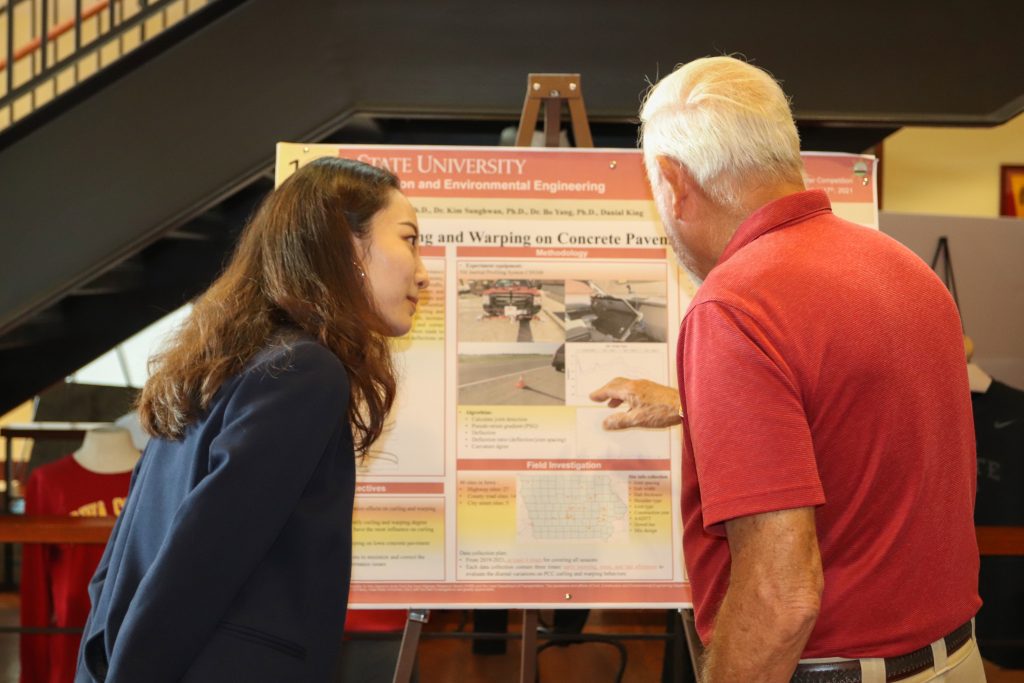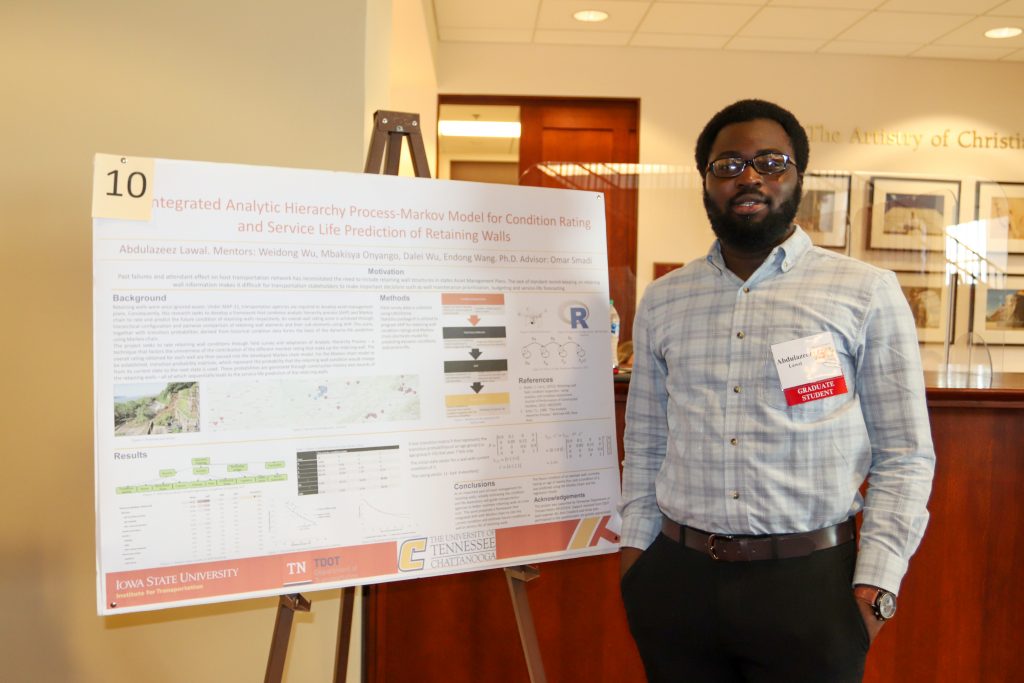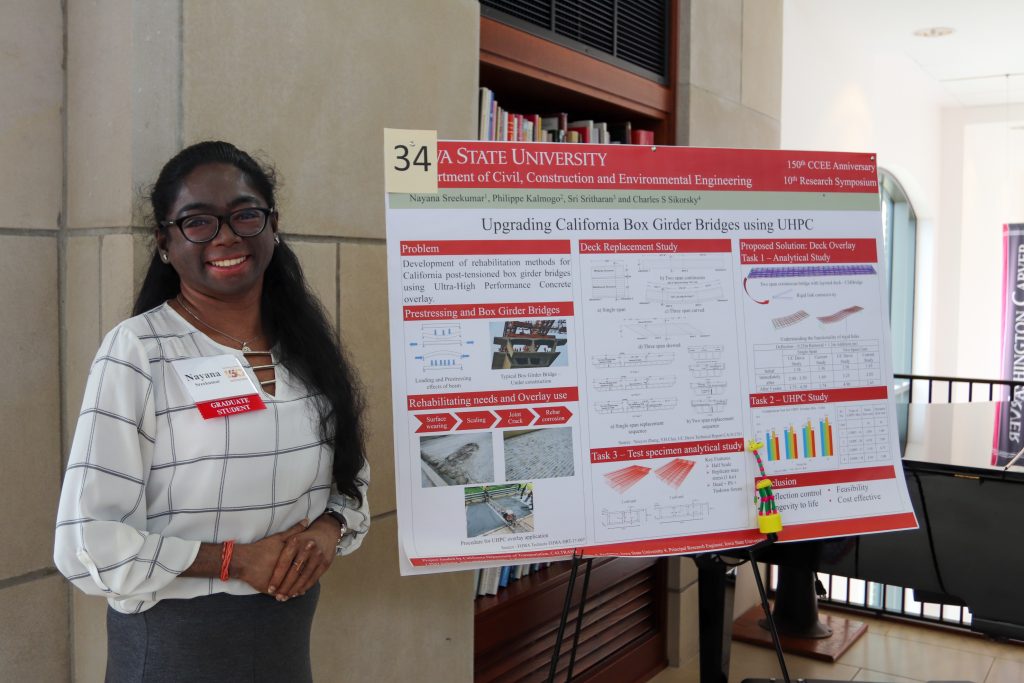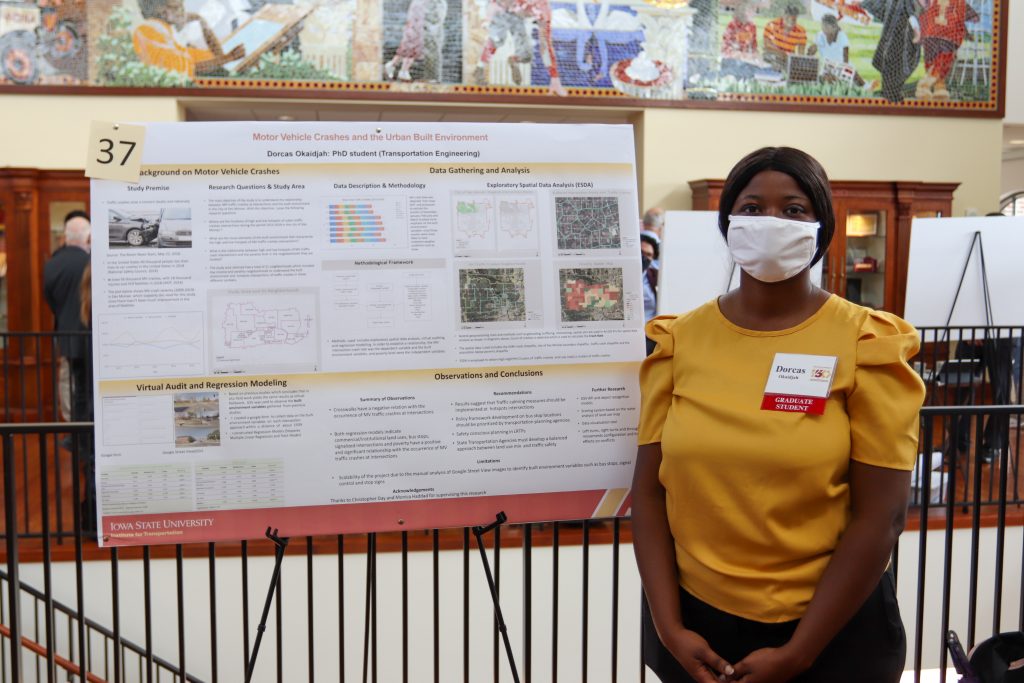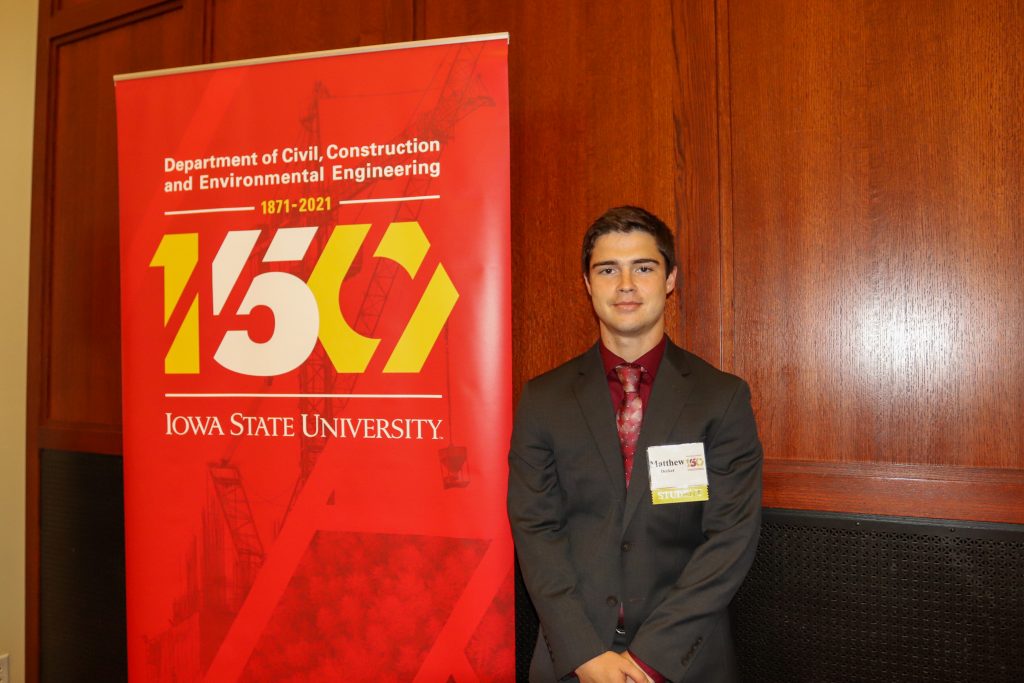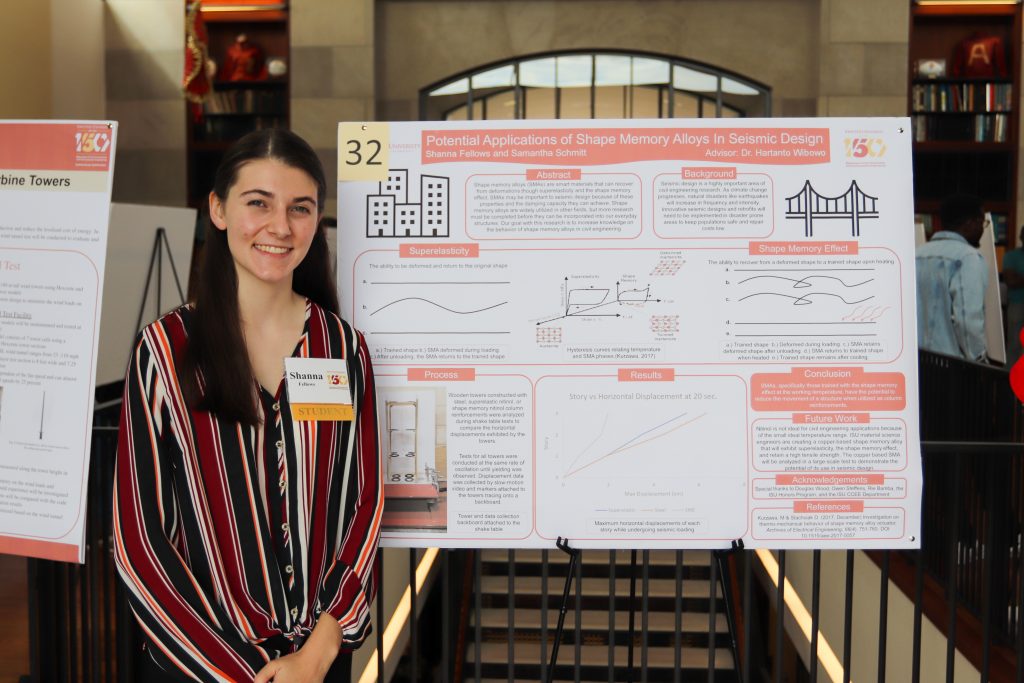The Civil, Construction and Environmental Engineering (CCEE) 150th Celebration included a Research Symposium for CCEE undergraduate and graduate students.
With over 40 presentations in attendance, there were overall awards, as well as specific ones pertaining to each specialty. The
categories have been split into Construction, Environmental, Geotech/Materials, Intelligent Infrastructure, Structures, Transportation and Undergraduate.
Construction
First Place: Toby Nii Tairo Nelson, Evaluating Differences Between Community And Stakeholder Perceptions About Water And Sanitation In Puerto Rico.
His research focuses on the gaps between community members and stakeholders in water and sanitation in Puerto Rico.
Second Place: Bukola Oni, Improved Project Planning Strategies for Transportation Assets: The Necessity of Early Stakeholder Involvement
Her research helps identify how stakeholder involvement can impact the directionality of a project, understand how stakeholders perceive the project outcomes, and identify what factors strengthen stakeholder involvement efforts by evaluating stakeholder involvement inland waterways.
Third Place: Bharath Melugiri Shankaramurthy, Influence of aggregate mineralogy and chemistry, vacuum pressure mixing on the durability of cementitious systems
His research explains how different factors influence the durability of cementitious systems, such as vacuum muxing, removal of air, aggregate type, and other properties. The focus is to understand the impact of those factors on concrete transport systems.
Environmental
First Place: Sina Moharramzadeh & Carter Klanderud, Stabilization and concentration of nitrogen in synthetic urine with Peracetic acid and Progressive Freeze Concentration
Their study uses Peracetic acid to prevent urea hydrolysis in synthetic urine to prevent nitrogen loss. They have combined different processes to stabilize, and collect urine to produce liquid fertilizer.
Second Place: Jarrett Morrison, Enhancing the Resilience of Houston’s Wastewater System Under Wet Weather Using Emerging Technology
His study looks at implementation of biofilm reactors in the city of Houston to improve the resilience of the wastewater system to combat extreme wet weather conditions and keep the wastewater treatment facilities performing.
Geotech/Materials
First Place: Hossein Emami Ahari, Global Warming Impacts the Shear Strength of Permafrost Soils
Ahari’s research focuses on the rise in global temperatures and the effect it has on permafrost soils and the stability of existing and new civil infrastructures. He presented testing on frozen and unfrozen soil, proposing a predicted model for the shear strength of soil with respect to temperature and water content.
Second Place: Hasung Kim, Development of Cyclic Borehole Shear Test Device
Kim developed an in-situ Cyclic Borehole Shear Test device. The device can be used to measure soil shear strength parameters, cyclic behavior of soil, and assessing soil liquefaction potential.
Third Place: Kexin Tian, Impact of Curling and Warping on Concrete Pavement
Using a high-speed profiler, Tian scanned the surface of pavement to identify the impact of curling and warping on surface smoothness and ride quality.
Intelligent Infrastructure
First Place: Abdulazeez Lawal, An Integrated Analytic Hierarchy Process – Markov Model for Condition Rating and Service Life Prediction of Retaining Walls
Lawal’s research combines the analytic framework process and Markov chair to rate the current state and future condition of retaining walls, predicting their service life.
Second Place: Amir Malakooti, Implementing a Self-Heating, Electrically Conductive Concrete Heated Pavement System for the Bus Stop Enhancement Project in the City of Iowa City
This proposal shows an alternative to snow removal, creating a sustainable concrete pavement system to improve the resiliency of infrastructure. This solution would allow places and sidewalks to be safe, open and accessible during harsh winter storms.
Third Place: Rohit Ghosh, Automated Detection and Classification of Pavement Distresses using 3D Pavement Surface Images and Deep Learning
Ghosh’s research focuses on accurate identification and classification of pavement distress, deterioration and failure, by using deep learning techniques. Deep learning techniques consist of machine learning and artificial intelligence, automating pavement distress detection.
Structures
First Place: Nayana Sreekumar, Upgrading California Box Girder Bridges using UHPC
Sreekumar’s project compares the performance of post tensioned box girder bridges with partial removal and replacement of the top of the deck, to the complete removal and replacement of the deck. This project’s knowledge can aid in the rehabilitation and strengthening of the bridge decks.
Second Place: Yongsung Koh, How are Iowa’s Road Infrastructures Damaged by Superloads?
This research quantifies the impacts of Superloads, also known as heavy-haul vehicles, on Iowa roads.
Third Place: Amilcar Del Rio, Evaluation of the performance of a Pier-Pile Cap-Pile system for ABC application
Del Rio’s research presentation designs and executes an outdoor test to evaluate the performance of Pier-pile cap-pile system, bridge support systems, for accelerated bridge construction application.
Transportation
First Place: Dorcas Okaidjah, Spatial Analysis of the Relationship between Intersection Crashes and the Urban Built Environment: A Case Study of Des Moines
This study explores the relationship between intersection crashes and the built environment. Over a seven-year period, Exploratory Spatial Data Analysis was used to identify crash clusters from the Iowa Department of Transportation. The study results show that commercial/institutional land uses, bus stops, and signalized intersections are significant and impact intersection crash incidence. Additionally, crash incidences were higher in neighborhoods with high household poverty percentages. This study can help policy makers make traffic design decisions and re-evaluation of bus-stop locations to reduce intersection crashes.
This presentation also won Most Creative Presentation.
Second Place: Maroa Mumtarin, Real-time Traffic Volume Prediction in Freeways during Hurricane Evacuation Using Data-driven Approaches
This project uses data collected from Hurricane Irma to predict evacuation traffic during hurricanes. They developed a real-time flow prediction model with real-time traffic volume starting at a point 50 miles back. The results indicate that incorporating traffic flow data from upstream significantly improves prediction accuracy.
Third Place: Ye Dong, Evaluation of Crash Contributing Factors
Understanding crash contributing factors helps with safety management and improving lives. These factors drive investment decisions, policies, regulations, and other safety improvements. In analyzing two national datasets in the US, CISS and NASS-CDS, they applied three taxonomies, it provides enhanced understanding of the various factors.
Undergraduate
First Place: Matthew Decker, Implementation of Subsurface Utility Engineering for Highway Design and Construction
Decker’s study synthesizes how different states implement subsurface utility engineering (SUE). The goal is to highlight best practices and current implementations of SUE.
Second Place: Zexi Yin, Experimental evaluation of wind loads on Hexcrete wind turbine towers
This research will develop models for the planned experimental evaluations in the Iowa State Aerodynamic/Atmospheric Boundary Layer Wind Tunnel.
Third Place: Shanna Fellows, Potential Applications of Shape Memory Alloys in Seismic Design
Fellows’ research presents field examples and experimental data to show the potential of shape memory alloys (SMAs) across many civil engineering applications. Using small scale tower tests on a shake table using SMAs and steel reinforcements, they were able to assess the abilities of SMAs to function in seismic design.
